Accounting Software for Medium Sized Business
April 28, 2021 5:00 pm | by John Adams

Medium Sized Business Accounting Software Made Simple
Are the day-to-day operations of your medium sized business taking up most of your day? SapphireOne is the complete all-encompassing accounting software solution for medium to large sized businesses – giving you the ability to focus on growing your business while taking care of all your accounting needs.
SapphireOne is more than basic Accounting software. Between our eight different Modes – Accounts, Inventory, Assets, PayRoll/HR, Job Projects, Management, Utilities and Workbooks – you will find all the tools you need to run your business within the one integrated Accounting software.
So if your business has outgrown its current software system, or you’re looking for a more robust solution to support your expanding enterprise operations, you will discover below why SapphireOne is the best accounting software for medium to large size business. Spend less time with paperwork and more time focusing on the things you love.
An integrated accounting solution to support your business
Why is SapphireOne suitable for medium sized businesses? SapphireOne offers integrated accounting software solutions for expanding medium to large sized business, designed to streamline and take the complexity out of day-to-day business operations.
Our below integrated modes and functionalities give you all the tools you need to run your medium to large size business operations. When tax time arrives, you’ll have all the information you need across all modes automatically updated in real-time within the one Accounting software.
Accounting Systems for Medium Sized Businesses
SapphireOne integrated accounting software is an all-in-one solution for efficient and compliant accounting operations. The SapphireOne Accounts Mode is a complete accounting software solution, including functionalities such as Bank Reconciliations, Direct Bank Entries, General Ledger, Client and Vendor Transactions, Multi-Company Accounting, Customer Relationship Management, Document Management and comprehensive reporting.
PayRoll Software for Medium Sized Businesses
Our integrated PayRoll and HR software covers diverse online PayRoll requirements, seamlessly connected to SapphireOne Accounting Mode for easy data transfer and real-time updates.
Our easy to use PayRoll and HR features include management of PayRuns, PayRoll Reporting, Rostering, Employee Details, Employee Benefits, Award Entitlements, Leave, Remuneration Inquiry, Allowances, and Tax Scales, to name a few.
SapphireOne is also Single Touch PayRoll certified, enabling employers to report salaries, wages, bonuses, Pay-As-You-Go withholding (PAYG) directly to the Australian Tax Office after each pay event. SapphireOne was the first to achieve world-wide full accreditation on 1 May 2018, giving you peace of mind by guaranteeing your business will be ATO compliant in just a few steps.
CRM for Medium Sized Business
SapphireOne inbuilt Customer Relationship Manager facilitates collecting, organising and managing customer information, and all information flows through to our ERP providing you with a well-defined overview of your customer. A few features of our CRM and accounting software include Customer Profiles, Document Management, Calendar, Notes, SoftPhone Integration and Voice Recording.
ERP Systems for Medium Sized Business
SapphireOne integrated ERP and accounting software is a complete business management software suite. It automates and integrates core business processes such as Financial Accounting, Inventory, Supply chain, Job Project Management, Asset Management, PayRoll/HR, CRM, Document Management, Soft-Phone and support for multiple foreign currencies and companies.
Integrated Project Management Software
SapphireOne Job Projects Mode facilitates the tracking of revenue and costs which are related to a specific task or job. By linking these items through the use of a Project ID, SapphireOne allows for easy and accurate assessment of the profitability of jobs, matters, projects or engagements undertaken.
The Job Projects Mode includes key functionalities such as Gantt Charts, Resource Management, Inventory Allocation, Timesheets, Transaction Inquiries, Rostering and Scheduling, Reporting and more – all seamlessly linked to your Accounts Mode for accurate financial tracking and analysis.
Business Accounting and Inventory Management Software
SapphireOne Inventory Management Mode is a complete solution for Inventory and Resource management.
SapphireOne Inventory Sales menu encompasses all the business-related documentation required to manage and provide goods and services to your client – such as Materials Requirements Planning (MRP), Bill of Materials (BOM), Manufacturing, Client Quotes, Client Orders, Picking Slips, Packing Slips and Client Invoices.
SapphireOne Inventory Purchases menu also gives you the full functionality for entering transactions, and ordering and purchasing of goods/services, including Vendor Orders and Vendor Invoices. Once verified, these transactions flow automatically through to the SapphireOne Accounts Mode to seamlessly create Client and Vendor accounting entries.
Drag & Drop Data Entry & PDF Capture Features
SapphireOne’s Drag & Drop and PDF Capture features are a game changer when it comes to streamlining data entry processes, and an incredibly useful tool for growing businesses to reduce errors and time spent manually entering complex data.
Using the Drag & Drop and PDF Capture features, SapphireOne users can eliminate manual data entry and make use of the feature to import and populate an unlimited number of line items and SKUs directly from excel files and PDF documents into the SapphireOne system, giving you the ability to complete data entry in a matter of minutes.
Connect with Industry Leading Apps
SapphireOne seamlessly integrates with many apps and platforms you already use to make running a business easy. Our API Partners include the likes of Shopify, ChannelAdvisor, WooCommerce, PayPal, Stripe, ATO, MailChimp, Western Union, Australia Post, Move It Brandscope, Oanda and we’re sure there will be some new ones that you will be happy you found.
All our clients have access to our full API suite, and we are continuously integrating with new partners to offer our clients ever evolving functionalities to meet their unique businesses requirements. You can check out our growing list of partners here, as well as read more about our customisable API solutions here.
Run Your Business from Anywhere at Any Time
SapphireOne supports both Mac and Windows operating systems simultaneously, and through our intuitive WebPack mobile application you can also send invoices, track expenses, communicate with customers and vendors, manage your Projects and Inventory levels and process Single Touch PayRoll compliant pay-runs all from the convenience of your Desktop, Phone or Tablet.
Using our TSPlus integration also gives SapphireOne users the ability to run remote offices from anywhere in the world, providing simple and secure access to the SapphireOne Client Server through a web browser.
Accounting Software for Growing Business
The above are just a few examples of the Modes and functionalities integrated within SapphireOne ERP, CRM and Business Accounting software, designed specifically as the complete accounting software solution to support medium to large sized business operations.
To find out more about SapphireOne integrated ERP, CRM and Business Accounting application and how our software caters to medium to large size businesses, please get in touch – we’re always here to help!
Benefits of Integrated Accounting Software
April 14, 2021 4:00 pm | by John Adams

There is no doubt that the many benefits of integrated accounting software has made it become one of the most indispensable tools for businesses of all types and sizes.
As a business owner, you would know that as your business expands it becomes increasingly more difficult to manually manage the financial and moving components of your business. If you are running multiple software applications for different functions of your business – such as Accounting, HR/PayRoll, CRM, Inventory Management – you would also know how challenging it can be to streamline the data and flow of information between seperate applications.
This is where integrated accounting software comes in, and has many benefits to offer that enables organisations to bring all components of the business together in order to streamline operations and facilitate growth.
SapphireOne ERP, CRM and Business Accounting software has been designed for this specific purpose – as an all-encompassing integrated accounting solution which includes multiple key modes and functionalities within the one application.
However, before we get into the details of integrated accounting software and its many benefits, let’s start by understanding what integrated accounting software actually is.
What is an integrated accounting system?
As the term suggests, an integrated accounting system is an accounting software that effortlessly combines and connects all major business functions into the one application, without the need for additional plug-ins or manual data manipulation.
In short, it eliminates the need to maintain separate books and software applications for different functions such as CRM, ERP, PayRoll and HR, Job Costing, Project Management, Inventory Management & more. For example, as all functions are run within the one application, it will automatically transfer the data from your Order Management mode into your Accounting mode, saving time and ensuring that your data is kept up-to-date at all times.
What are the benefits of an integrated accounting software package?
An accounting system can deliver great benefits to any business, however these benefits are amplified with an integrated accounting system, which automatically receives and transfers a constant flow of data across all your business operations.
- No More Additional Plug-Ins
An integrated accounting software eliminates the need for additional and often expensive software or plug-ins to fulfil all your related business requirements, as everything is housed within the one application. This means no more manual data transfer or manipulation, and reduces the risk that the systems will not pass or update the information correctly. - Seamless Transfer of Data
As all functions are run within the one application, the system will automatically transfer the data between all modes. This not only saves time and effort, but also reduces the chances of any human error. Plus, the system receives a constant flow of data, keeping it up-to-date at all times. - Ensure More Reliable Data Entry
Standalone accounting software requires you to manually enter your Customer, Vendor, PayRoll and Inventory data from one application to another. Not only is this a timely process, it often results in duplication or incompletion of data, and there is no guarantee of the reliability of data as this process is prone to human error. Implementing an integrated accounting system eliminates the need for any manual data entry and removes all challenges of double or missing entries and reduces chances of human error. - Speed Up Decision Making
The manual data entry process that is required for standalone accounting systems increases the chance that you will not have the updated financial information needed to make quick and informed decisions. An integrated accounting software means you can easily avoid this issue as it provides you with a real-time view of all transactions as they happen. The information from each module automatically flows into the accounting system as the transactions occur and remains updated at all times.
SapphireOne best integrated accounting software

SapphireOne’s ERP, CRM Business Accounting software includes eight core business modes, guaranteed to cover all key business functions for medium-large size businesses within the one integrated accounting software application.
These eight modes include Accounts, Inventory Management, Projects, Assets, PayRoll and HR, Management, Utilities and WorkBook – all seamlessly integrated within the one application. The modes include the below key functionalities, just to name a few!
Accounts – Financial Accounting Software
SapphireOne integrated accounting software is an all-in-one solution for efficient and compliant accounting operations. The Accounts Mode includes functionalities such as Bank Reconciliations, Direct Bank Entries, General Ledger, Client and Vendor Transactions, Multi-Company Accounting, Customer Relationship Management, Document Management and Comprehensive reporting.
SapphireOne business accounting software is also ATO Single Touch PayRoll certified, and enables employers to report salaries, wages, bonuses, pay-as-you-go withholding (PAYG) directly to the Australian Tax Office after each pay event.
CRM – CRM and Accounting Software
SapphireOne CRM and accounting software facilitates collecting, organising and managing customer information, and is also integrated into our ERP to provide a well-defined overview of your customer.
A few features of our CRM and accounting software includes Customer Profiles, Document Management, Calendar, Notes, SoftPhone Integration and Voice Recording.
ERP – Integrated ERP Software
SapphireOne integrated ERP and accounting software is a complete business management software suite. It automates and integrates core business processes such as Financial Accounting, Inventory, Supply chain, Job Project Management, Asset Management, PayRoll/HR, CRM, Document Management, Soft-Phone and support for multiple foreign currencies and companies.
PayRoll and HR – Integrated PayRoll and HR Software
SapphireOne integrated HR and PayRoll software covers diverse online PayRoll requirements, and seamlessly connects to SapphireOne Accounting Mode for easy data transfer and updated information. Our easy to use PayRoll and HR features include management of PayRuns, PayRoll Reporting, Rostering, Employee Details, Employee Benefits, Award Entitlements, Leave, Remuneration Inquiry, Allowances, and Tax Scales to name a few.
Inventory Management – Business Accounting and Inventory Management Software
SapphireOne Inventory Management software provides all features required to perform inventory management. SapphireOne Inventory Sales menu encompasses all the business-related documentation required to manage and provide goods and services to your client – such as Materials Requirements Planning (MRP), Client Quotes, Client Orders, Picking Slips, Packing Slips and Client Invoices.
SapphireOne Inventory Purchases menu also gives you the full functionality for entering transactions, and ordering and purchasing of goods/services, including Vendor Orders and Vendor Invoices. Once verified, these transactions flow automatically through to the SapphireOne Accounts Mode to seamlessly create Client and Vendor accounting entries.
Job Projects – Integrated Project Management Software
SapphireOne Job Projects facilitates the tracking of revenue and costs which are related to a specific task or job. By linking these items through the use of a Project ID, SapphireOne allows for easy and accurate assessment of the profitability of jobs, matters, projects or engagements undertaken.
The Job Projects Mode includes key functionalities such as Gantt Charts, Resource Management, Inventory Allocation, Timesheets, Transaction Inquiries, Rostering and Scheduling, Reporting and more – all seamlessly linked to your Accounts Mode for accurate financial tracking and analysis.
Bringing it all together
Integrated accounting software is rapidly becoming a necessity for all businesses. After all, having all functionalities integrated within the one application means that there is no information in isolation, and integration leads to smooth flow of information between all functions of the business.
To find out more about SapphireOne integrated ERP, CRM and Business Accounting Software and the benefits of integrated accounting software, please feel free to get in touch with a member of our team – we’re always here to help!
SapphireOne’s Jack Adams competes at the 2021 FIS Alpine World Ski Championships in Cortina, Italy.
February 23, 2021 11:00 am | by John Adams

Jack Adams competes for New Zealand in the Giant Slalom and Slalom at the 2021 FIS Alpine World Ski Championships.
Congratulations to SapphireOne sponsored athlete Jack Adams who has just competed in the FIS Alpine World Championships in Cortina, Italy. The event is held every second year and showcases the best alpine athletes from around the world.
In the Giant Slalom Jack placed 32nd in the Qualifying race, just missing out on the finals, and achieved an impressive overall ranking of 50th.
In the Slalom Jack fought hard in Run 1 on a course that challenged the best in the world, with 30% of the field being a ‘Did Not Finish’ (DNF). Jack moved from 71st to 35th after the first run and was ready for Run 2.
In Run 2 he was on track for a top 20 result, and just a few gates from the finish line hit one bump too many and joined the 70% of athletes that had a DNF.
We are all extremely proud of Jack and his efforts at his first World Champs, and look forward to following his progress through the rest of the season. We also thank SnowSports NZ for giving Jack the opportunity to be part of a major event surrounded by the best in the world.
Video edited by Steve Kantarelis. Blog by Suzie Adams and Maddie Kent.
SapphireOne Accounts Receivables Report Tutorial: The Statements Report
January 4, 2021 8:35 am | by John Adams

Creating an Accounts Receivables Statements Report in SapphireOne.
For the next post in our Accounts Receivables Report Tutorials, we will be focusing on the fourth Accounts Receivables reporting option in SapphireOne, the Statements Report.
There are six different types of Accounts Receivables reporting options available within SapphireOne. This includes:
- Details
- Balances
- Transactions
- Statements
- Show Reports
- Dashboards
In our previous three posts we looked at the Client Details Report, the Balances Report and the Transactions Report. Read on to learn more about when and how to create the Statements Report, and make sure you are getting the most out of all SapphireOne reporting functionalities.
The Statements Report.
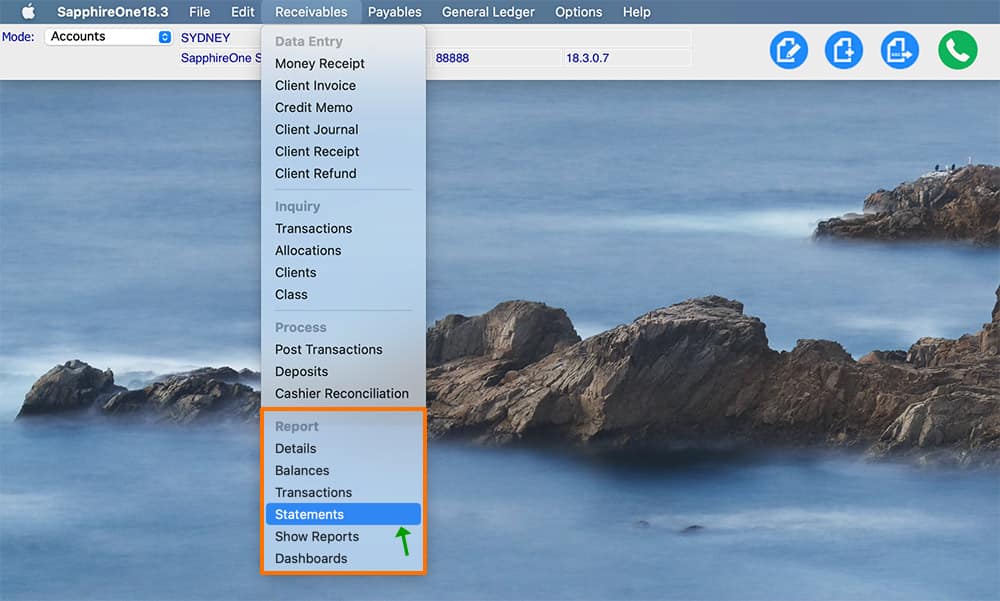
The Accounts Receivables Statements Report gives you the ability to produce different Statement layouts. This report is helpful for debt collection as it gives you the ability to produce a report to give to Clients to show they currently have outstanding.
The Statement Report presents a print dialog pop-up for the selection of the items required to be printed in the report.
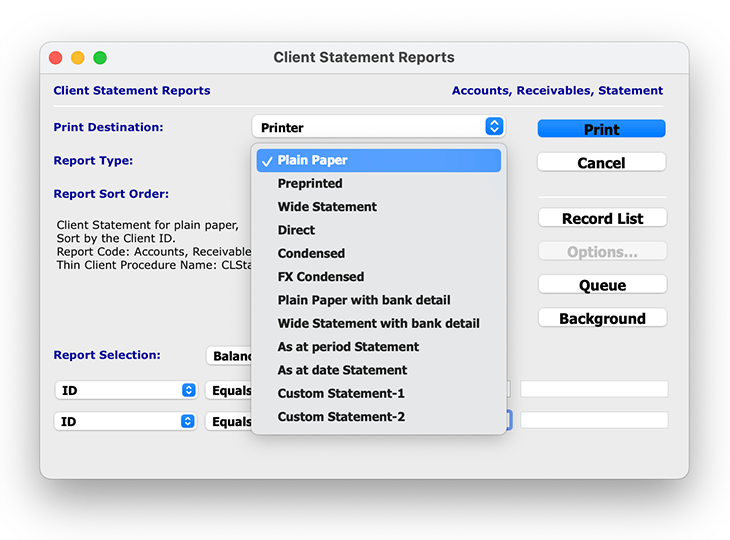
When ‘Printer’ is selected from the Print Destination drop-down menu, the ‘Report Type‘ menu gives you the ability to report on 12 different Statement Report types. This includes:
- Plain Paper – This report will print a statement onto blank paper whether using Laser or Image-Writer printers. All lines, graphics etc will be printed.
- Pre-Printed – This is for printing statements onto pre-designed forms. The lines and graphics will already be on the forms.
- Wide Statement – This report will print a landscape statement onto blank paper (Laser or Image-Writer).
- Direct – This is for printing to serial printers. The layout is set up from the Direct Print control in ‘Utilities’. Navigate to: Utilities/Controls/Direct Print Layouts
- Condensed – This report produces a compressed report for filing purposes with the same data as a statement.
- FX Condensed – This report produces a client statement report in foreign currency, and is compressed for filing purposes.
- Plain Paper with Bank Detail – This produces a statement report on plain paper with the clients bank details in portrait.
- Wide Statement with Bank Detail – This is a two section landscape report with a detailed statement on the left and a remittance on the right. The second section is a simple statement/remittance, and provides an area where the amount being paid may be entered and the entire page returned.
- As at Period Statement – This function enables the user to print statements based on an ending period. A pop up will ask for the entry of a period.
- As at Date Statement – This function enables the user to print statements based on a date as entered. A pop up will ask for the entry of a date.
- Custom Statement-1 – This is a Custom Report statement that has been set up in ‘Utilities’. Navigate to: Utilities/Controls/Custom Report Layouts.
- Custom Statement-2 – This is a Custom Report statement that has been set up in ‘Utilities’. Navigate to: Utilities/Controls/Custom Report Layouts.
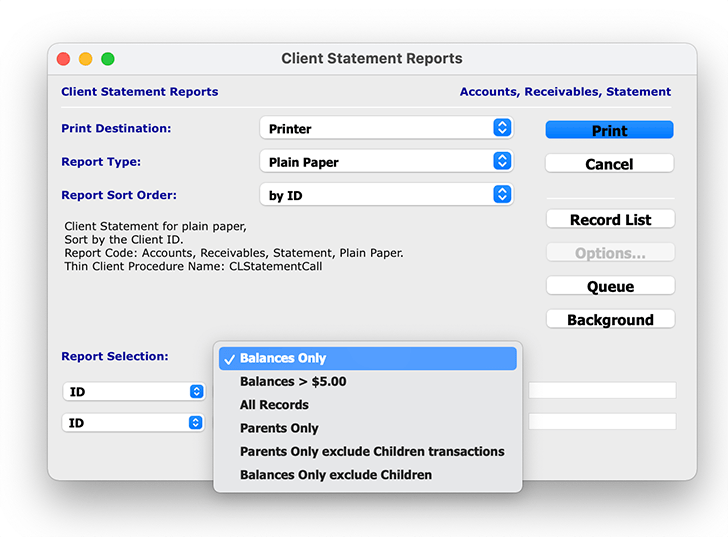
The ‘Report Selection’ drop-down menu gives you the ability to select which clients statement data you would like to report on, allowing you to get more granular and specific with your reporting capabilities.
- Balances Only – This is the default selection and the system will only print out Client balances for those who do not have a balance of $0.00.
- Balances > $5.00 – This report is the same as the default report, however it will only include Clients who have a balance owing of $5.00 or more.
- All Records – This option prints a report for all Clients irrespective of balances owing. In some instances this will be a very large report as Clients with a balance of $0.00 will be included.
- Parents Only – This option will only print those Clients who are recognised by the system as parents and have a balance owing.
- Parents Only exclude Children Transactions – This option will only print those Clients who are recognised by the system as parents and have a balance owing. Any child transactions will be excluded.
- Balances Only exclude Children – This option will print balances for all Clients, except those who the system recognises as Children of Parents.
Once you have chosen your defined report details, and selected ‘Print’, you have the option to open the report as a PDF or print the report directly from SapphireOne.
Any questions?
For the next final post in our next Accounts Receivables Reporting Tutorials we will be focusing on the remaining two ‘Show Reports’ and ‘Dashboards’ reporting functionalities within SapphireOne.
For more information on Accounts Receivables Reports, or to find out how you can get the most out of your SapphireOne application, please contact us or book a call with a member of our Support Team. We are always here to help!
SapphireOne Accounts Receivables Report Tutorial: The Transactions Report
December 21, 2020 9:51 am | by John Adams

Creating an Accounts Receivables Transactions Report in SapphireOne.
SapphireOne has six different Accounts Receivables reports options, each allowing you to report dynamically on client data for many different purposes.
- Details
- Balances
- Transactions
- Statements
- Show Reports
- Dashboards
In our previous tutorials we looked at how to create the first two Client Details Report and Balances Report in more detail. This post focuses on the third Accounts Receivables report option within SapphireOne, the Transactions Report.
Continue reading to learn more about when and how to use the Accounts Receivables Transactions Report, and stay up-do-date on all reporting functionalities available with SapphireOne.
The Transactions Report.
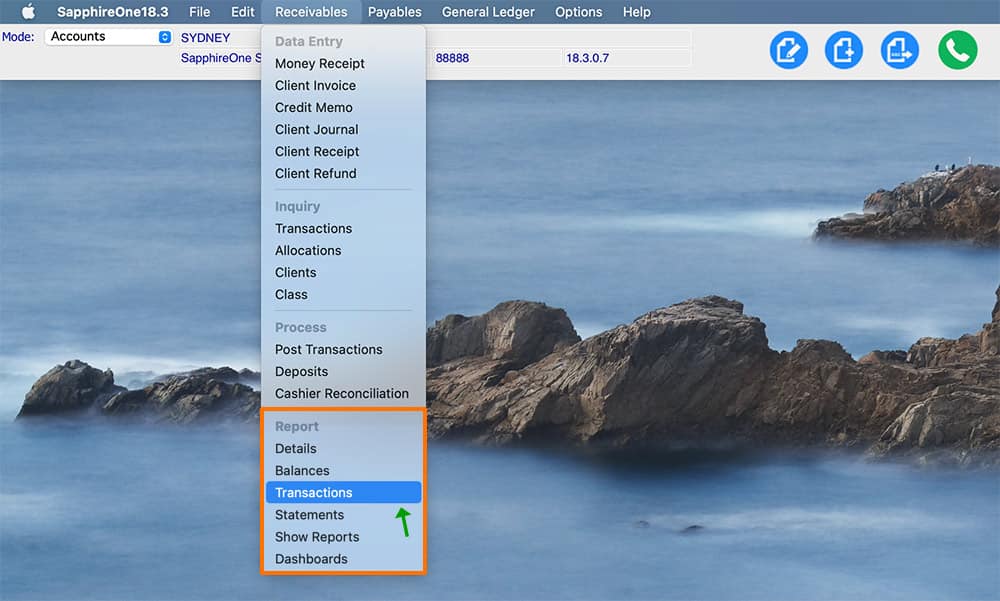
The Client Transactions Report gives you the ability to generate a list of all outstanding transactions via a variety of different criteria and fields contained within your SapphireOne Client data profiles.
When selecting the Transactions Report, you are presented with the following print dialog pop-up enabling the selection of items required in the report:
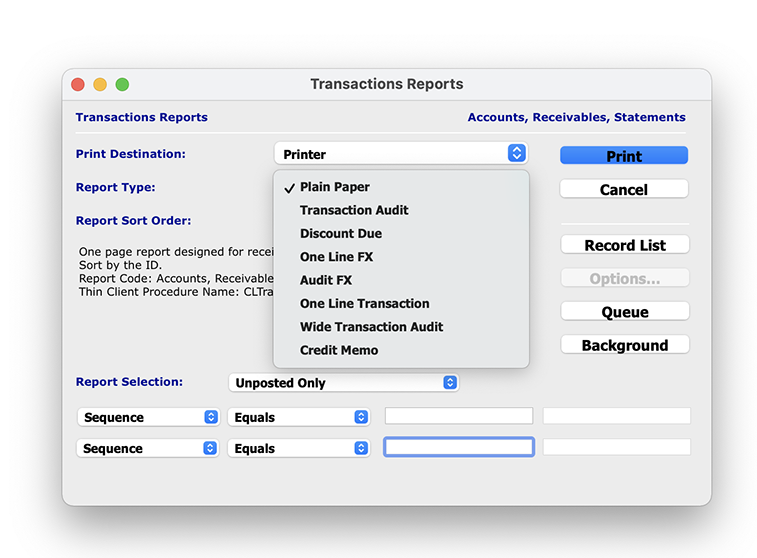
When ‘Printer’ is selected from the Print Destination drop-down menu, the ‘Report Type’ menu gives you the ability to create 8 different Transaction Report Types depending on your specific reporting requirements. This includes:
- Plain Paper – This report is a one page report designed for receipts only.
- Transaction Audit – This report gives the Tracking Details of the transaction and the value. It also includes Sub-Lines showing where the transaction was allocated.
- Discount Due – This report gives the details of Discounts due to the Client on each transaction. This includes the number of days the discount is limited to, the percentage amount and the actual amount in dollars.
- One Line FX – This report gives the Tracking Details of Foreign Currency transactions and its value.
- Audit FX – This report is as above for the One Line FX report but also includes the Sub-Lines showing where the Foreign Currency transaction was allocated.
- One Line Transaction – Gives the Tracking Details of the transaction and the value.
- Wide Transaction Audit – Landscape version of the Transaction Audit report above.
- Credit Memo – This option allows you to create a credit memo when required.
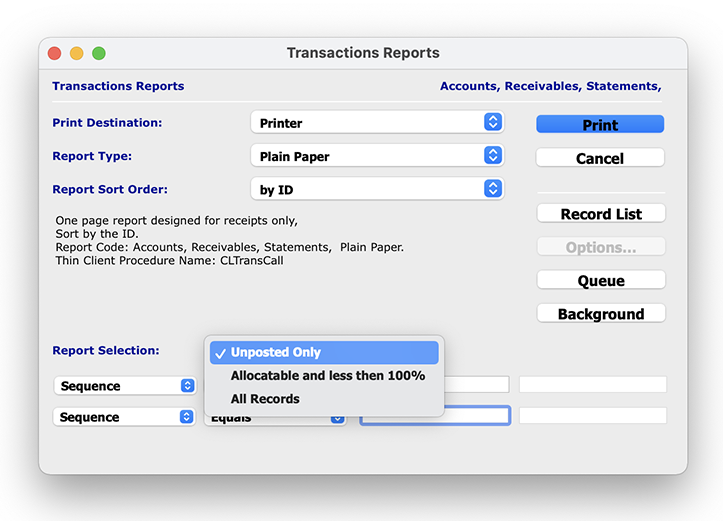
The ‘Report Selection’ drop-down menu also allows you to select which Client transaction data you would like to report on, allowing you to get more granular and specific with your reporting capabilities.
- Unposted Only – This option creates a report for all transactions that are not posted and have not been transferred to the GL.
- Allocatable and less than 100% – This option creates a report for transactions that have not yet been allocated at 100%.
- All Records – This option prints a report for all Clients irrespective of balances owing. This also includes all Clients with a balance of $0.00.
Once you have chosen your defined report details, and selected ‘Print’, you have the option to open the report as a PDF or print the report directly from SapphireOne.
Any questions?
Stay tuned for the next blog post in our next Accounts Receivables Report Tutorials, where we will be diving into the Statements Report.
For more information on Accounts Receivables Reports, or to learn how how you can get the most out of your SapphireOne application, please contact us or book a call with a member of our Support Team. We love hearing from you!
Make Your Life Easier with SapphireOne’s Integrated Document Management
May 26, 2020 8:32 am | by John Adams

Some more so than others, but nearly all types of transactions involve paperwork needing to manually be sorted through and filed appropriately. This process is time-consuming and quite frankly, not very exciting for any accounting team member. However, SapphireOne has developed a solution readily available to your company as it offers an ERP software application with an integrated document management.
An ERP framework is a versatile accounting tool that supports the incorporation of different segments of any day-to-day business, ranging from processing of orders to managing inventories and shipments etc. Metaphorically speaking, an ERP software is the ‘Swiss army knife’ of data management. If it is coupled with an integrated document management system, the process of filing any paperwork stemming from various business activities becomes a walk in the park, as the two components work hand in hand to facilitate efficient and effective document management for any organisation or company.
The Benefits of Integrated Document Management
There are five distinct advantages for you and your company related to adopting SapphireOne’s ERP solution in respect of document management tasks such as sorting, searching and filing:
1. Time- and Labour-Efficient
An ERP system with the capacity for integrated document management allows you to conveniently sort and file large amounts of paperwork created by various transactions electronically with ease. The process also becomes much less labour-intensive, meaning your accounting team can shift their focus on more productive tasks.
2. Fluidity and Departmental Integration
The ERP solution offers the possibility of making your company function like one single beehive, interconnecting it on all fundamental levels and consequently, enabling instantaneous sharing of information between all departments, which leads to a high degree of fluidity that is desirable for any type of business. For instance, the customer service team will not need to contact the accounts department anymore in order to retrieve details on inventory, locations, taxes, customers or any other relevant information. Instead, any department can access all data directly via an ERP dashboard.
3. Privacy and Security
Any integrated management of documents via an ERP software application enables the implementation of a risk-stratified security protocol for accessing sensitive information contained within them. As a result, you can effectively specify and monitor who is able to, as well as who actually accesses, any protected data.
4. Lower Management Expenses
Unlike manual processes of organising, filing, sorting and searching paperwork, electronically managing documents incurs no additional expenditures for printing and storage of such. Further, it also reduces the need of allocating valuable human resources to tasks such as searching and filing of documents, as these can be attended to electronically i.e. in a more efficient manner. A reduction of paper consumption also has the positive outcome of improving the eco-friendliness of your company.
5. Improve Decision-making Process
An ERP compatible with integrated document management enhances your as well as your employees’ decision-making skills. By easing the access to all relevant data and information pertaining to branches such as sales, expenses and general transactions, all possible options and outcomes can be weighed up. Resultingly, the decision-maker can rest assured that the ultimate outcome is based on a foundation of thorough research. It is essentially the accumulation of such critical decisions that determine the fate of a company.
The integrated document management system offered by SapphireOne excels with its capacity of attaching documents to transactions and all major tables. If you would like for your business to be able to take advantage of all the aforementioned benefits, it is as easy as implementing SapphireOne’s world-class ERP, CRM & Business Accounting Software. Please contact us to request a live demo and/or read the testimonials from our long-standing clients.
